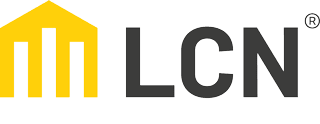The Local Control Network in Practice
LCN automates all functions within your home – from lighting and shutter control to access control. This does not require any technical knowledge or complicated controls. The system is completely flexible and can be expanded at any time without much effort. If you would like to download details as documents, you can do so in the LCN Service section.
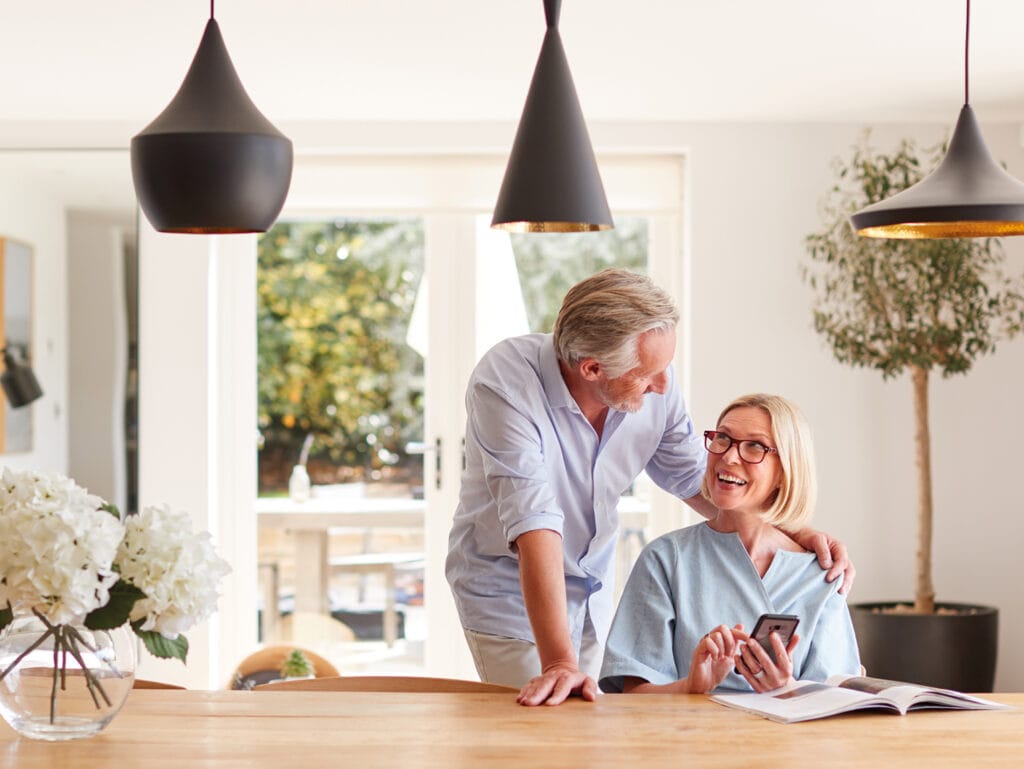
Because LCN offers you a wide range of functions!
LCN is particularly easy to install, as it does not require its own cable network. Only one free wire in the existing house installation.
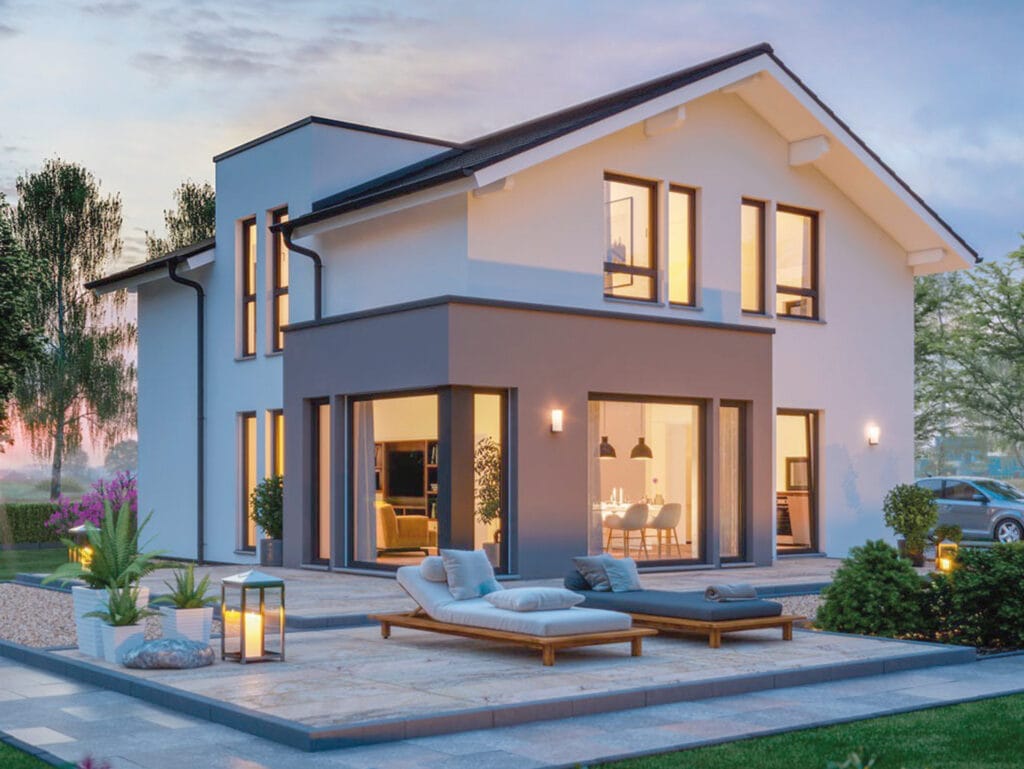
Light off - Spot on
In private households, lighting requires a good 8% of the Electricity demand*. Saving electricity in lighting is possible through automation with the Local Control Network, by also giving intelligence to lighting. The lights that save the most electricity are those that are not turned on in the first place. Motion detectors in the LCN system only switch on lights when someone is actually detected in the vicinity. If the person leaves the detection range of the sensor, the light is switched off again after a transition period.
The LCN modules can dim and switch either incandescent lamps as well as LED systems. Especially where a lot of energy is used for lighting, such as in open-plan offices and high-rise buildings, constant lighting control is becoming increasingly popular. Intelligent lighting with LCN. Even Philips HUE lights can be controlled, wirelessly of course.
Your home set in the right light
With LCN, all lighting tasks are implemented with the most ecologically, economically and functionally attractive variant in each case. Modular solutions enable partners from the luminaire manufacturing industry to build intelligent lighting systems cost-effectively. Lighting designers and installers can use the right configuration for the specific task based on the multifunctional modules.
Both the proven 0-10V technology, the DMX protocol and the DALI lighting control allow a high degree of flexibility. From intelligent individual luminaires to a comprehensive lighting concept for buildings, which can also be linked with emergency lighting to form a common system. With LCN it is possible. In presence-controlled lighting systems, the use of LCN brings a new level of energy efficiency, safety and comfort.
Constant light controls ensure that artificial light in a room is used only to supplement daylight. Sensors register the currently available daylight, the presence of people in the room and, if necessary, other factors. LCN ensures that exactly the amount of light needed for the work areas is available at defined points in the room, instead of constantly running all luminaires at full power.
Not only does this avoid unnecessary costs, protect the environment and create optimal working conditions. It also avoids glare effects, which can be just as annoying as too little light. uch controls require complex control functions and the processing of many values. The LCN system is already ideally equipped for such tasks in its structure.
Combined methods for maximum results
LCN relies on the linking of standardized technologies. This enables complete integration of the lighting control in the LCN system and thus central control of all functions with only one system.
During the course of the day, very different light is often needed or desired in the same places. During cooking and housework, the kitchen should be bright, with rather cool light. At dinner, it may be less light, with a little more red components. In the living room, when working at the desk, that’s exactly where a lot of light is needed. An hour later, while watching TV or chatting with guests, a completely different lighting is desired. When relaxing with Bach or Chopin similar, but again different. Thus, for just one room, a dozen different illuminations can be useful.
Each LCN module can store up to 100 light scenes. Since all modules communicate and exchange data independently, a lighting scenario for an entire house can be called up with the touch of just one button on a keypad. Or just for the dining table in the kitchen. But LCN not only controls, but also reports. For example, if the light is still on in the children’s room late at evening.
Especially in transit areas such as corridors, basements or storage rooms, light is often needed only for a short time. Motion and presence sensors report when people have entered or left an area, so that the light is only switched on for this period. This is not only convenient, but also increases safety. Not infrequently, both hands are needed to carry things in the garage or storeroom, the LCN system takes care of the lighting, the tedious search for the light switch is eliminated and shortly after leaving the room the light goes out again. Without anyone stumbling because there was no hand free for switching on the light.
Sometimes even little light is enough. For example, when getting up at night. Depending on the time of day or the brightness of the day, lights in the hallway or bathroom are only switched on automatically after getting up, dimmed considerably. Or the Corona® light of the GT pushbutton series serves as a night light. Especially for seniors or people with limited mobility, this is a plus in safety and convenience.
Air conditioning equals heating plus ventilation plus shading
Everyone knows that it is not a good idea to leave the window open or tilted for hours in winter when the heating is on. Also, the different temperature zones in the house, such as the bedroom, bathroom and living room, are often not heated to what the actual heat demand is. Temperature-guided heating controls with outdoor sensors were an initial advance, but they cannot take into account conditions or needs in the home. Home automation with the Local Control Network simplifies heating control through automation by incorporating internal as well as external factors and the habits of the residents.
Appropriate sensors and actuators can be used to optimize the energy required for heating. For this purpose, both actual and setpoint temperatures are included in the control, as well as time- and location-dependent factors. Thus, a night temperature of 18 °C is usually sufficient in bedrooms. The living room may be 21 °C to 22 °C, but it is not appropriate to maintain these temperatures even when no one is in the house. Therefore, when leaving the house, even in winter, the temperature in all rooms is reduced. It is brought back into the comfort zone either by time of day, or when the occupants return to the house, or in advance from the office using the LCN-GVS app just before work ends. The sauna can be preheated at the same time.
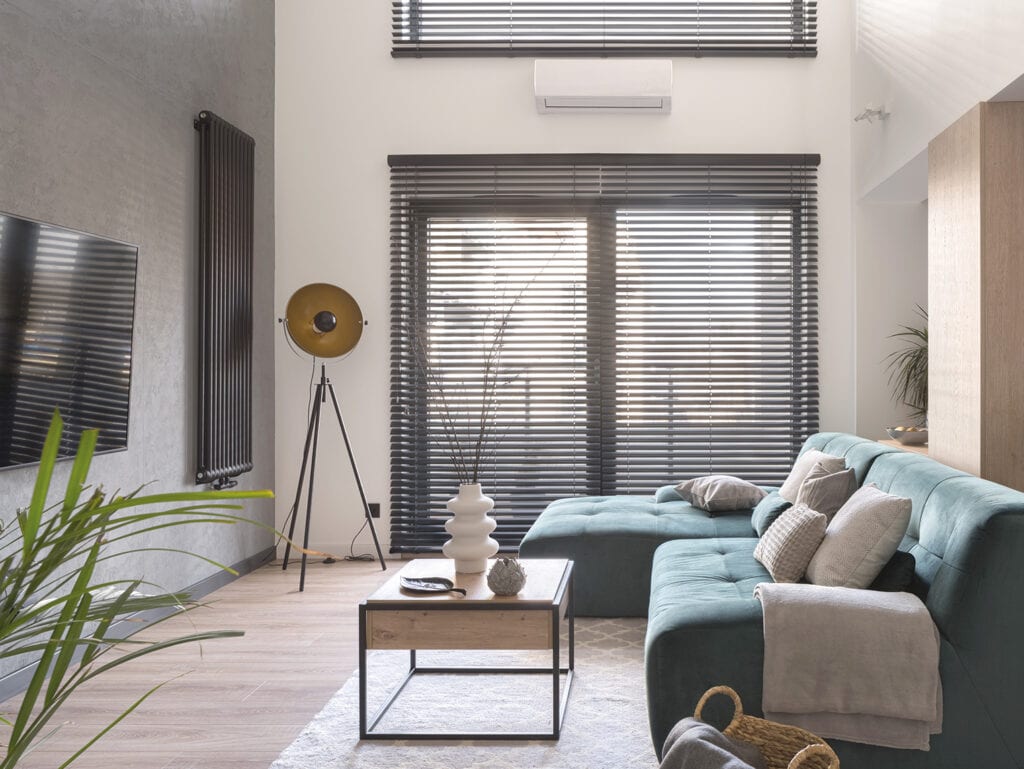

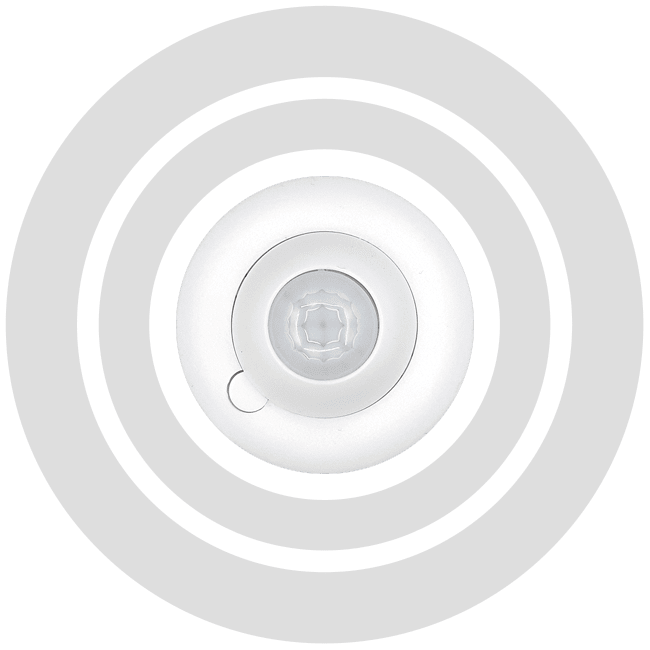
Security requires intelligence
More safety thanks to intelligent automation
Even the best alarm technology should not be left to itself. Especially for one’s own sense of security, it must be possible to find out about the current status in the house. The global visualization system LCN-GVS allows to check the current status of the house from any location via any web browser, whether motion detectors or other sensors in the house have responded since the last check and whether all lights are switched off. In addition, actions can also be triggered remotely, such as closing shutters or switching lights.
With the graphical interface of the LCN-GVS, this visualization is not a tool for technicians or specialists, but a tool for everyday use and for every user. How the graphical interface is designed is decided by the user with the installer, from elaborate background images with lots of details to simply labeled icons. The easiest way is to use the LCN-GVS app for smartphones, which optimizes the network traffic at the same time.
Especially in your home, you want to have the greatest possible security, who enters the house and when. LCN can be used to reliably set up access control, with people identifying themselves using RFID cards and chips, car keys or – for maximum security – the LCN-GFPS fingerprint sensor. Access can also be restricted in terms of time and space. With electric door closing systems, finely graded access to the building is allowed, for the particular person at those doors and at those times. If an RFID card is lost, it is simply deleted from the system. With LCN visualization even from a distance.
Access protection in commercial properties is even more important. With the LCN-GVS, a virtually unlimited number of access options can be created and stored, even for different buildings. So one ID card is valid for all the company’s buildings. Different user groups in the LCN-GVS allow the HR department to issue new cards, but not to access heating or air conditioning. And to ensure that it is clear afterwards who entered the building when and where, everything is meticulously logged. Then there will be no more discussions about who was late.
The best protection against burglary is a house that appears inhabited. Since the greatest danger to one’s property comes from marauding gangs who do not plan the burglary in advance, a presence simulation can provide additional security in advance. Here the universal sensor LCN-GUS offers some possibilities by closing the shutters only below a certain daylight. Due to changing weather, this changes the closing time. Only in the morning the shutters are opened again by timers in the LCN-GVS Global Visualization.
Additionally, LCN home automation switches certain lighting on and off in the evening or at night. The presence simulation is perfected by different closing times of the roller shutters or switching of the lighting, which are determined by values such as outside temperature or daytime brightness. An alternative to this is to program the timers in the LCN visualization differently for the days of the week. While not every burglary can be prevented with such a simulation, most burglars prefer to steer clear of an inhabited house.
If an emergency has occurred and there has been a break-in or the cellar is under water due to a burst washing machine hose, further measures should be taken quickly. Possibly, a pre-alarm could still prevent a burglary in case of unexpected movements in the garden. In such a situation, the LCN system can send so-called push messages that land in the LCN smartphone app and inform about unusual situations in the house. Information can also be forwarded to residents or other contacts via SMS or e-mail.
The LCN system is outstanding compared to other solutions for building automation in that both small apartment and large commercial buildings can be automated. This in turn requires that multiple installations can also be managed from a single central instance. This is provided for with LCN and the LCN-GVS from the basic structure and thereby also benefits the private user. Push messages are a viable way to be quickly and reliably informed about situations in the building, be it a burglary or the failure of the heating system.
The home is not only threatened by burglars or vandals with spray cans. Weather can also affect a house, such as heat, heavy rain or storms. Even a tilted window and heavy rain can cause enough trouble. Weather stations like the LCN-WIH measure wind speeds, rain and outdoor temperatures. Extended awnings or external blinds could easily be damaged in strong winds. During heavy storms, it is recommended to lower shutters to protect windows from wood breakage. The LCN system is informed of such weather conditions and closes windows or shutters and retracts awnings or outdoor blinds.
The LCN-WIH provides even more information, including outdoor temperature, brightness and GPS data. The GPS data can be used to calculate the position of the sun, the temperature sensor reports how warm it actually is, and the brightness sensor reports how much sun arrives. Before the house can heat up excessively, shading measures are initiated. In the cold season, the weather station works to the heating control system so that frost damage never occurs in the house. Weather-guided control of all the technologies involved in the smart home also ensures that the house is protected.
Many security breaches occur due to inattention or carelessness. By automating security, momentary influences such as the waiting cab or the overslept customer appointment no longer play a role. An out-of-home button on the LCN-GT6 at the front door closes all windows, turns off all lights, as well as the sockets in the kitchen. Alarm mode will be activated. Rooms are monitored with motion and heat sensors, and windows and doors are controlled with locking contacts and glass break detectors.
If the alarm mode remains active for a longer period of time, the presence simulation is added, the heating is lowered and roller shutters are closed automatically. If you even forget to press the out-of-home button, the house will set itself to alarm mode after a long period of inactivity, thanks to LCN. In this way, LCN takes over the attention to the safety of the house.
At home around the world
LCN-GVS is the global visualization software for monitoring and operating any number of LCN systems. It can be used in small facilities as well as for very large, globally distributed properties. Any number of visualization stations can be active simultaneously via Internet browsers. A comprehensive authorization system gives each user or user group individual rights for monitoring or control.
The LCN-GVS simultaneously extends the functionality of an LCN installation. It complements the system with global timers, access control for a virtually unlimited number of people and buildings, and calendar functions and macros for simplified programming.
Another visualization is offered by the LCN-VISU, which is simply installed as a module in a distribution and controlled via browser. It offers a list view and a tile view over all actuators and sensors and can be set up in 5 minutes. Since the LCN-VISU is based on the international standard openHAB, it can be easily coupled with many third-party systems such as voice assistants, audio control and many more.
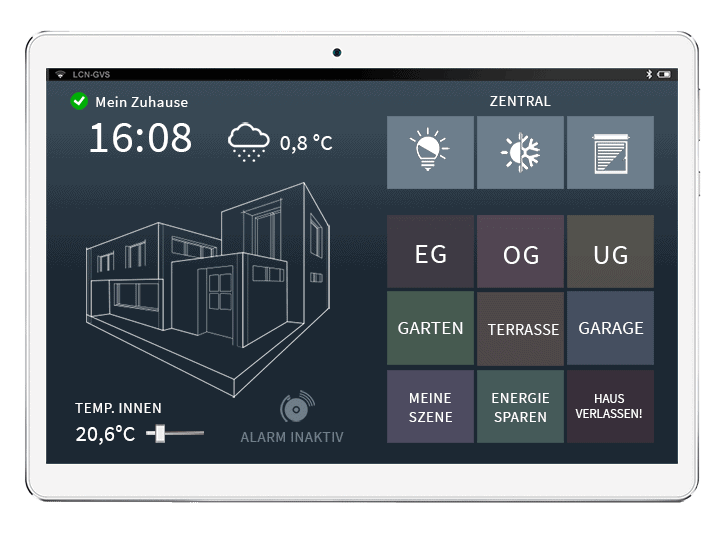

System independence through web browser as interface
The access point to an LCN installation is any PC running Microsoft® Windows® on which the LCN-GVS is installed and there is a connection to the LCN bus. At the same time, this PC is integrated into the local network and can thus be accessed within the building and, if desired, also from outside. From the outside, of course, only encrypted and via individual access data. Any web browser, whether on a notebook, on a smartphone or even from a game console, can now access the LCN-GVS and control or monitor the installation.
In the visualization, so-called tableaus are created, graphical surfaces of any level of detail, on which control elements, but also sensors or lamps are placed. This allows the LCN installation to be operated and monitored remotely. For example, it can be evaluated whether sensors in a room have responded, which lights are switched on or what temperatures prevail in a room. Since the LCN system with its four-level acknowledgement and reporting system can reliably determine the status of modules, you always see the actual state of the installation, not the expected one.
Additional functions of the LCN-GVS are:
- Macros are used to simplify programming.
- Timers trigger functions according to date and time, the switching times can also be changed interactively in the panels.
- Global calendars trigger or deactivate functions, for example, as a vacation calendar in schools, lights and heating remain off during this time.
- Access control data for transponders is managed and distributed centrally. A transponder card or fingerprint access for a vacation home can be scanned in Hamburg and used in Valencia. With precisely defined times, from when and for how long access is allowed.
In the private home, visualization serves primarily to increase comfort and security. All functions are also available remotely. For example, already turn on the heating during the drive home. At the same time, operation is simplified because functions can be integrated into different panels according to customer requirements.
Application
- Video surveillance also remotely
- Control of the building via browser or app even abroad via internet
- Control of the building or apartment via smartphone, tablet or panel PC
- Setting the light color or color temperature via light scenes or via HSB color wheel
- Central functions: Switch off any consumer, close all windows, etc – all with one click.
- Event notifier with push notification directly to smartphones, email and SMS. Open windows, heating malfunction – everything is reported immediately!
In industrial and commercial buildings, efficiency and safety aspects play a major role. Downtime should be minimized, property protected and functions automated.
Application
- Group control e.g. of windows, lighting etc.
- Monitoring of protective equipment such as fuses, fire alarm systems, etc.
- Integration of the visualization into the building control system via Modbus, OPC and BACNet
- Cross-building management of access rights: Who is allowed to enter what at what time?
- Fingerprint access control: central management of biometric data in the personal database together with transponders.
- Central management of all company buildings: monitoring of consumption values, air conditioning units, alarm systems, etc. Cross-building tableaus for individual trades arbitrarily possible.
Whether city hall, sports hall or school building: LCN-GVS can be used to conveniently manage multiple, locally separated properties. Businesses with multiple locations or branches can benefit. New properties can be integrated into existing systems.
Application
- Evaluation and further processing of working times by exporting as CSV file
- Control conference rooms, including lighting scenes, electric screen and audio
- Central control of the building: for example, by janitors or property managers
- Visualization of consumption or generation values such as water, electricity or photovoltaic output
- Individual management of switching times with calendar function, e.g. in schools, where the use of space can vary a lot.
- Individual access rights for user groups – not only to tableaus, but also to each individual function: full/display only/invisible.
As an open bus system, LCN allows couplings to almost all systems. In this way, a higher-level control system can access the LCN bus directly. Extensions are possible at any time via license key:
- Timer
- Building user for access control
- External system coupling (BACnet, Modbus, OPC)
- Control of SONOS sound systems and Philips HUE lights via the in-house WLAN
- Event and fault indicators for print, mail, SMS, etc.
- Much performance, low price due to modular pricing
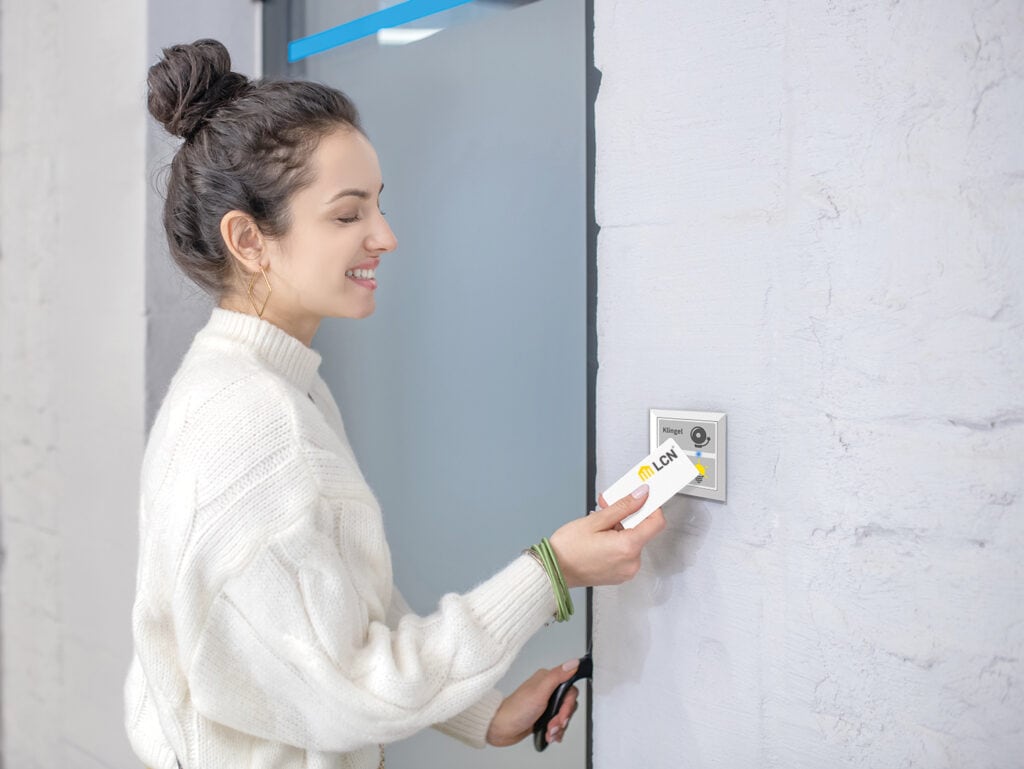
Who may do what where and when
Access control already plays a role in the private home, but it becomes vital in the commercial sector, where expensive goods and machines have to be protected against theft or damage. Security issues can go much further, namely protecting company know-how, protecting data, or accessing critical or hazardous materials.
Access protection cannot simply be implemented with a few keys. It must also be taken into account that in a larger private house or in a company allowed activities must be divided in a fine granular way. The human resources department can create ID transponder cards for new employees, but does not have access to the heating system. The janitor of a home may only enter the garage and basement during the owners’ vacation, but housekeeping may only enter the house. An LCN installation can easily meet such demands with its intelligent modules, extensive sensor technology and visualization.
More safety thanks to intelligent automation
The LCN-GFPS sensor uses the biometric data of a fingerprint for identification. After the impression has been scanned in a small window, a transponder code is generated on the basis of the unique features, which uniquely identifies the user. Access control via biometrics has the advantage of high security, as no keys or cards can be lost or forged.
Application
- GT series design
- Up to 1000 fingerprints teachable
- LED display and elegant Corona® light
- Fingerprint identification with live fingerprint recognition
- Evaluation by LCN module or visualization LCN-GVS
- LCN access control with central management of biometric data
The LCN-ULT is a universal transponder reader for indoor and outdoor use. The LCN-ULT reads not only LCN transponder cards, but also passive transponder types from various manufacturers as well as almost all car keys. The front door key becomes practically superfluous. The car key is sufficient to gain access to properties and buildings.
Application
- Weatherproof encapsulated
- For mounting on flush-mounted box
- Available in white color
- Evaluation by LCN module or visualization LCN-GVS
- Access system for car keys, transponder watches and almost all commercially available transponders
The LCN-RT is a multifunctional infrared remote control. Up to 16 different functions can be triggered via four multi-assignable buttons, with a range of up to ten meters. The LCN RTs have unique serial numbers and can be individually programmed and personalized. In this way, each user gets specific access rights. Since every keystroke sends this information, a complete usage documentation can be created and archived.
Application
- Personalized access
- Access system via IR remote control
- Four-way key assignment (short, long, go)
- Also controls lights, shutters, heating and much more

The LCN-GVS visualization is an important component of a company-wide access control system. It not only takes care of managing virtually unlimited access data for all locations and parts of the company. It also allows to create user groups with precisely defined rights and capabilities via visualization. Furthermore, only those functions can be released for individual areas that they need and can handle. Functions can be access to access data, to the infrastructure of the company or access to parts of the building. If desired, these functions can apply to specific times or until a defined date, for example, for interns.
LCN visualization can be used for access protection in the private sector as well, especially in distributed buildings, for vacation homes or purely for convenience. With the transponders of the LCN system, many car keys can be read and open the front door. Lost keys to a home locking system are a security risk and an expensive proposition. A lost transponder card is simply deactivated and is inexpensive. And sometimes it’s just reassuring to check that everything is okay at home when you’re on vacation.
We are here for you
We support you during commissioning, technical execution, troubleshooting and parameterisation.
Give us a call!

